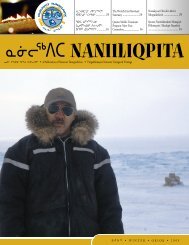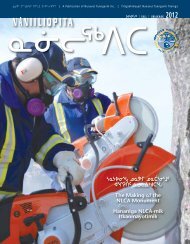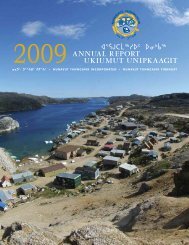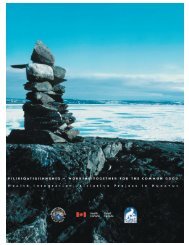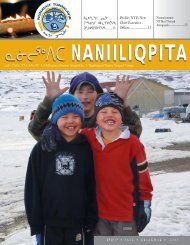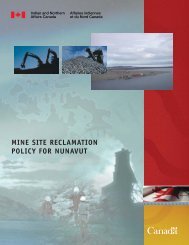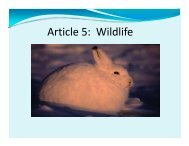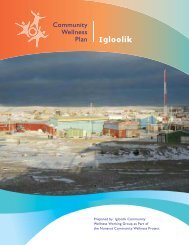Ensuring a Sustainable and Humane Seal Harvest - Nunavut ...
Ensuring a Sustainable and Humane Seal Harvest - Nunavut ...
Ensuring a Sustainable and Humane Seal Harvest - Nunavut ...
Create successful ePaper yourself
Turn your PDF publications into a flip-book with our unique Google optimized e-Paper software.
Other Management <strong>and</strong> Enforcement IssuesThe Committee heard complaints that the Annual Forum on <strong>Seal</strong> <strong>Harvest</strong>Management, now held annually, took place at locations <strong>and</strong> times inconvenient for manyharvesters. Recent fora were held in St. John’s, Newfoundl<strong>and</strong> <strong>and</strong> Labrador inNovember 2005 <strong>and</strong> in Halifax, Nova Scotia in January 2007. Several sectors active in theseal harvest were apparently not represented, <strong>and</strong> therefore their points of view were notfully considered. The Committee believes that, in the future, consultation sessions shouldbe held where the fishermen <strong>and</strong> harvesters are located, <strong>and</strong> at times of the year that areconvenient to them.In 2006, DFO established a TAC of 2,000 animals for personal use. According tothe Department, since 1995 residents adjacent to sealing areas throughout Newfoundl<strong>and</strong><strong>and</strong> Labrador <strong>and</strong> Quebec (sealing areas 5 to 20) can harvest up to six seals for personaluse. There were 1,761 personal use seal licences issued in 2002. The Committee believesthat this practice should continue as long as harvesters continue to be trained <strong>and</strong> hold theproper licence. Currently however, personal use harvesters are not allowed to sell the sealpelt as a by-product of their activity; the Committee believes this situation should be reexamined.Increase in the Grey <strong>Seal</strong> Population <strong>and</strong> the <strong>Harvest</strong>On May 30, 2006, the Committee heard from the Grey <strong>Seal</strong> Research <strong>and</strong>Development Society about concerns over the increasing grey seal population <strong>and</strong> DFO’sapproval of a commercial harvest of 10,000 grey seals over two years along the AtlanticCoast of Nova Scotia. Dr. Mike Hammill, a research scientist working for DFO, told theCommittee that “back in the 1970s there were probably 20,000 grey seals in all of AtlanticCanada. Today the population has increased to [between] 250,000 [<strong>and</strong>] 260,000 <strong>and</strong> thelargest concentration is found around Sable Isl<strong>and</strong> on the Scotian Shelf. Probably abouttwo-thirds of the population is on the Scotian Shelf <strong>and</strong> one-third in the Gulf ofSt. Lawrence.” 51The grey seal is one of the six species of seals found off the Atlantic coast ofCanada. It is much larger than the harp seal. For the Northwest Atlantic grey sealpopulation, the male measures up to 2.3 m <strong>and</strong> weighs 300-350 kg, <strong>and</strong> the femalemeasures up to 2.0 m <strong>and</strong> weighs 150-200 kg. Pups weigh 11-20 kg at birth <strong>and</strong> areweaned at about three weeks of age. Grey seals feed on a wide variety of fish,crustaceans <strong>and</strong> cephalopods. But more importantly, when compared to the harp seal,grey seals are present <strong>and</strong> feed in the Gulf <strong>and</strong> on the Scotian Shelf year round.51Mike Hammill, Committee Evidence, November 9, 2006.21




